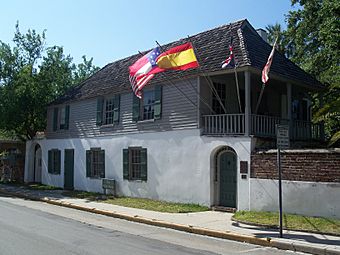González–Álvarez House facts for kids
|
González–Álvarez House
|
|
|
U.S. National Historic Landmark District
Contributing Property |
|
 |
|
| Location | 14 St. Francis St., St. Augustine, Florida |
|---|---|
| Area | 2 acres (0.81 ha) |
| Built | circa 1723, 1775–1786, 1790 |
| Architectural style | Stone Vernacular |
| Part of | St. Augustine Town Plan Historic District (ID70000847) |
| NRHP reference No. | 70000845 |
Quick facts for kids Significant dates |
|
| Added to NRHP | April 15, 1970 |
| Designated NHL | April 15, 1970 |
| Designated NHLDCP | April 15, 1970 |
The González–Álvarez House, also known as The Oldest House, is a special historic home in St. Augustine, Florida. You can find it at 14 St. Francis Street. This house is thought to be the oldest one still standing in St. Augustine, with parts of it built around 1723.
It's a great example of the building style used by early Spanish settlers. Later, British owners made some changes to it. In 1970, it was named a U.S. National Historic Landmark. This means it's a very important place in American history. Today, the St. Augustine Historical Society owns the house. You can visit it as part of the Oldest House Museum Complex and see how people lived during Spanish, British, and American times.
Contents
What Makes This House Special?
The González–Álvarez House is in a quiet neighborhood south of downtown St. Augustine. It's a two-story building. The first floor is made from a unique stone called coquina. The top floor is built with wood and covered with wooden boards. It has a sloped roof with wooden shingles. The house shows how it was changed and made bigger over many years, as different countries ruled Florida.
The land where the house stands has been used since the 1600s. The oldest part of the house, the first floor, was built around 1723. At that time, a soldier named Tomás González y Hernández and his family lived there. He worked at the Castillo de San Marcos, a famous fort nearby.
How the House Was Built
The house's design was perfect for the local weather and materials. It was built using coquina, a soft limestone found nearby. The main thick walls face east and west. On the east side, there's an open porch called a loggia. This design lets cool breezes from the southeast blow through the house, keeping it comfortable. The thick walls also help keep the heat out. The floors inside are made of a strong material called tabby concrete.
Changes Over Time
When the British took control of Florida in 1763, the González family moved to Cuba. In 1774, an Englishman named Major Joseph Peavett bought the house. He added the wooden second story and put glass windows where there used to be only wooden shutters.
Later, the third owner, Geronimo Alvarez, made the house even bigger. He added a two-story section also made of coquina. In 1918, the St. Augustine Historical Society took over the house. They worked to restore it in 1959–1960, making it look like it did in the late 1800s.
Families Who Lived Here
Many families have called the Oldest House their home throughout history. Each family added to its story.
- First Spanish Period (before 1763)
* 1625–1763: The family of Tomas González y Hernández and María Francisco de Guevara.
- British Period and Second Spanish Period (1775–1882)
* 1775–1790: Joseph Peavett and Maria Evans. * 1790–1882: The family of Gerónimo Álvarez and Antonia Vens.
- Into Statehood (1882–present)
* 1882–1884: William B. Duke family. * 1884–1898: Mary Carver and Dr. Charles P. Carver. * 1898–1911: James W. Henderson family. * 1911–1918: George T. Reddington and the South Beach Alligator Farm. * 1918–present: St. Augustine Historical Society.
Gallery








